|
|
Monographs |
|
|
|
|
|
|
|
|
|
|
|
Monograph 1 |
|
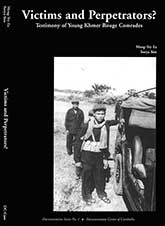 |
VICTIMS AND PERPETRATORS:
The Testimony of Young Khmer Rouge Cadres
Meng-Try Ea and Sorya Sim
2001
13USD
76 pages in English,
150 pages in Khmer
A note on
the Front Cover Photo
|
|
In
Democratic Kampuchea’s Region 31, the Khmer Rouge recruited
children to serve as
guards, “catchers,” and animal husbandry
workers in Tuol
Sleng Prison (S-21). This monograph explores how these and other
Cambodian youth were forced to become Khmer Rouge cadres, how they
were indoctrinated in the ideology of Democratic Kampuchea, how they
were affected, and the violation of their rights.
The authors used Khmer Rouge biographies and interviews with 73 people
to collect information on these youths. Eighteen of those interviewed
were Khmer Rouge cadres at S-21, 22 are family members of deceased
S-21 cadres, and 33 are survivors of the regime. The authors conclude
that these children were victims as well as perpetrators.
Funding
provided by the Human Rights Project Funds of the Foreign and Commonwealth Office of the United Kingdom through the British Embassy,
Phnom Penh, Cambodia, and the Government of Norway. |
|
|
|
|
|
|
|
Monograph
2 |
|
|
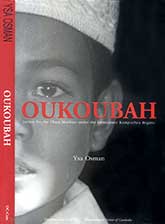 |
OUKOUBAH:
Justice for the Cham Muslims under Democratic
Kampuchea Regime
Ysa Osman
2002
22USD
154 pages in English, 205 pages in Khmer
|
|
This monograph explores the genocide of the Cham ethnic
group,
making a case that the Cham, who are Muslims, were killed a rate that was
nearly double to triple that of the general Cambodian population
during the Democratic Kampuchea regime. It provides evidence showing
that the Cham comprised 10% of Cambodia’s population prior to 1975
(about 700,000 people), but numbered only 200,000 after the regime
fell in 1979.
The author presents case studies of 13 Cham prisoners at S-21 (7 Khmer
Rouge soldiers, 2 Lon Nol government officials, a student, a
fisherman, a peasant, and an interrogator at S-21), all of whom were
executed at the prison.
Funding
provided by the Human Rights Project Funds of the Foreign and
Commonwealth Office of the United Kingdom through the British Embassy,
Phnom Penh. |
|
|
|
|
|
|
|
Monograph
3 |
|
|
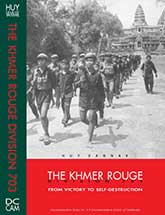 |
THE KHMER ROUGE DIVISION 703:
From Victory to Self-destruction
Huy Vannak
2003
22USD
203 pages in English, 250 pages in Khmer
|
|
One of the most favored of the Khmer Rouge’s nine military divisions,
Division 703 was composed of 5,000 to 6,000 peasants,
primarily from Kandal province. At the end of 1975, its soldiers with “clean”
backgrounds were given positions at Tuol Sleng (the central-level
prison also known as S-21) or its branch office S-21D (Prey Sar
prison) and various government offices. At least 567 of these men were
later branded as “enemies” of the regime and executed at S-21.
This monograph examines the careers of 40 soldiers who worked in
Division 703. Most of those who survived the 1979 defeat of the Khmer
Rouge returned to their villages in the early 1980s, often after
spending time in prison as a result of their involvement with the
regime.
Funding
provided by the United States Department of State, Bureau of
Democracy, Human Rights and Labor. |
|
|
|
|
|
|
|
Monograph
4 |
|
|
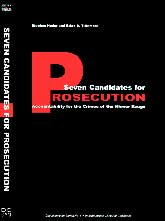 |
SEVEN CANDIDATES FOR PROSECUTION:
Accountability for the Crimes of the Khmer Rouge
Stephen Heder and Brian Tittemore
2004
12USD
153 pages
in English (executive summary in Khmer)
247 pages
in Japanese Language
|
|
This study
examines the responsibility of seven
senior officials for their roles in developing and implementing the
murderous policies of the Communist Party of Kampuchea (CPK), known to
its enemies as the “Khmer Rouge”:
|
|
|
|
§ |
Deputy Secretary of the CPK Central Committee Nuon Chea, who is
implicated in devising and implementing the Party’s execution
policies. |
|
|
§ |
Deputy Prime Minister for Foreign Affairs and Central and Standing
Committee member Ieng Sary, who repeatedly and publicly encouraged
and facilitated arrests and executions within his ministry and
throughout Cambodia. |
|
|
§ |
Democratic Kampuchea State Presidium Chairman Khieu Samphan, who
encouraged lower-level CPK officials to perpetrate executions and,
at least in some instances, monitored and contributed to the
implementation of Party policies by regional authorities. |
|
|
§ |
Zone
Secretaries and Central Committee members Ta Mok and Kae Pok, who
directed or otherwise facilitated their subordinates’ arrests of
suspected traitors in their zones, and failed to prevent or punish
atrocities perpetrated by their subordinates. |
|
|
§ |
CPK Military Division Chairmen Sou Met and Meah Mut, who played
direct roles in the arrest and transfer of cadre from their
divisions for interrogation and execution, and failed to prevent
or punish atrocities perpetrated by their subordinates. |
|
|
While
extensive work has been done to document and analyze evidence of CPK
crimes generally, this is the first comprehensive legal analysis of
available evidence against specific individuals for international
crimes. Heder and Tittemore also shed new light on how the CPK
designed and implemented the CPK’s policies of mass execution.
Funding
provided by the Swedish International Development Cooperation Agency
and the OSI Development Foundation (a Swiss charitable foundation). |
|
|
|
|
|
|
Monograph
5 |
|
|
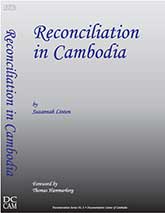 |
RECONCILIATION IN CAMBODIA
Suzannah Linton
2004
26USD
274 pages
in English (executive summary in Khmer)
|
|
For the first time,
Cambodia’s
struggle to deal with its tragic past is
put into global context through an examination of the growing
of literature in this area, and comparisons with the
experiences of
such countries as Chile, Argentina, Rwanda, South Africa, and East
Timor.
The heart of this study is analysis of the extensive data collected by
DC-Cam’s magazine, Searching for the Truth, in the course of a
public survey of its Cambodian readers in 2002. The author provides
insight into the attitudes and perceptions of ordinary Cambodians on a
range of issues relating to the Khmer Rouge: accountability, revenge,
forgiveness, reconciliation, and their vision for the future.
Funding provided by
the OSI Development Foundation, the United Kingdom, US Agency for
International Development (USAID), and Sida (Sweden). |
|
|
|
|
|
|
|
Monograph
6 |
|
|
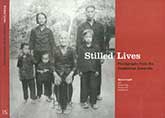
|
STILLED LIVES:
Photographs of the Cambodian Genocide
Wynne Cougill with Pivoine Pang, Chhayran Ra, and
Sopheak Sim
2004
15USD
127 pages in English, 118
photographs
|
|
This book contains photographs and essays on the lives of 51 men
and women,
who joined the Khmer Rouge during the 1960s and 1970s. They were
what the Khmer Rouge called “base people”: those from the peasant
class who generally were treated less harshly than the “new people”
(city dwellers and those associated with the former Lon Nol regime).
The people profiled here served the Khmer Rouge as farmers, soldiers,
security personnel, or cadres (those with some degree of command
responsibility). Although most Cambodians view the former Khmer Rouge
as cruel and sometimes evil, this book shows that they and their
families faced the same struggles and hardships as their victims, and
points to our common humanity.
Funding provided by the National Endowment for Democracy (NED).
|
|
|
|
|
|
|
|
Monograph
7 |
|
|
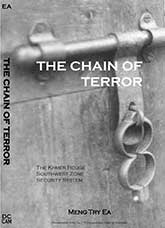 |
THE CHAIN OF TERROR:
The Khmer Rouge Southwest Zone Security System
Meng-Try Ea
2004
15USD
150 pages
in English
|
|
The Khmer Rouge security (prison) system was set up at virtually every
political level throughout Democratic Kampuchea. This
monograph examines the structure of the security system in the
regime’s Southwest Zone, which was considered a model for the
revolution, but contained over 250 security centers (DC-Cam has
located over 6,000 mass grave sites in this zone). It examines the
execution chain at the sub-district, district, region, and zone levels,
and the relationships of the centers within the zone.
Funding provided by Swedish International Development Cooperation
Agency (Sida) and the United States Agency for International
Development (USAID) through The Asia Foundation.
|
|
|
|
|
|
|
|
Monograph
8 |
|
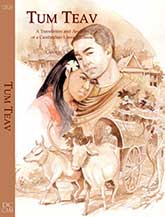
|
TUM TEAV:
A Translation and Analysis of a Cambodian Literary Classic
George Chigas
2005
20USD
252 pages
in English
|
|
Tum Teav
is the tragic love story of a talented novice monk named
Tum and a
beautiful adolescent girl named Teav. Well known
throughout Cambodia since at least the middle of the 19th century, the story
has
been told in oral, historical, literary, theatre,
and film
versions. This monograph contains the author’s translation of the
Venerable Botumthera Som’s version. It also examines the controversy
over the poem’s authorship and its interpretation by literary scholars
and performers in terms of Buddhism and traditional codes of conduct,
abuse of power, and notions of justice.
Funding provided by NZAID (New Zealand).
|
|
|
|
|
|
|
|
Monograph
9 |
|
|
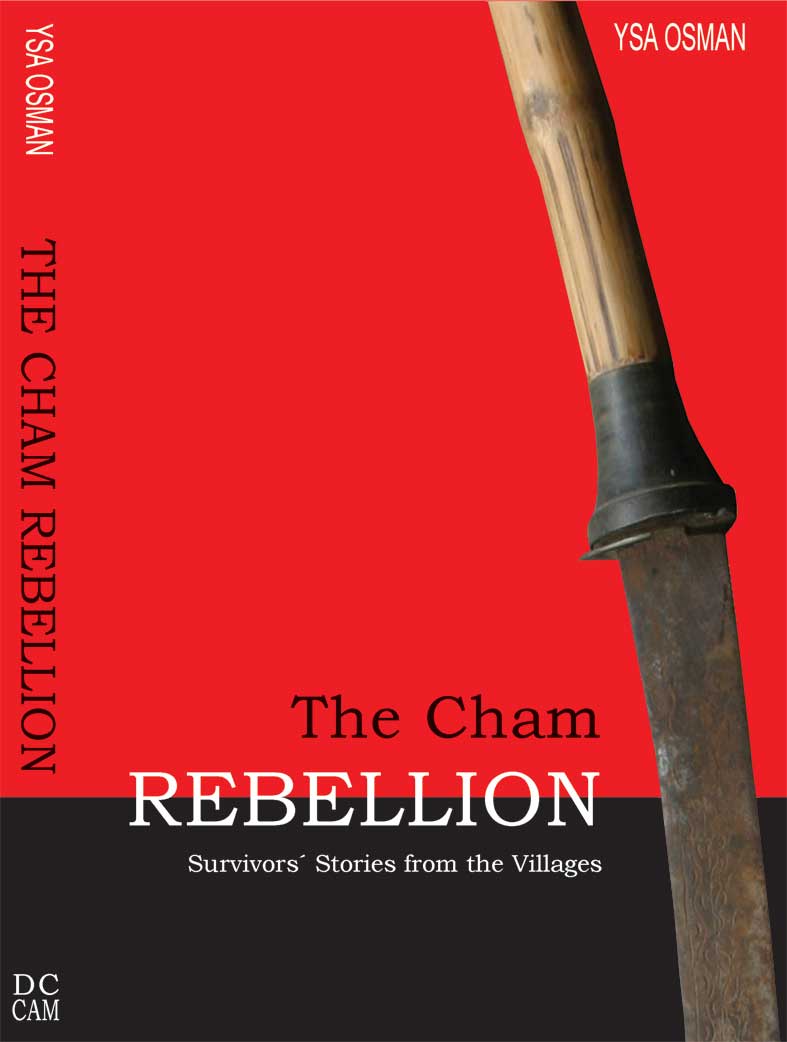 |
THE CHAM REBELLION:
Survivors' Stories from the
Villages
Ysa Osman
2006
15USD
184 pages
in English
|
|
In
October 1975, two Cham Muslim villages in Kampong Cham province staged
brief and ill-fated rebellions against
their
oppressors, who had banned the practice of Islam. Armed with swords,
knives, sticks, stones and two guns, they killed a member of the subdistrict committee
and the chief of the district youth group. After the
rebellions were put down, the survivors were deported to malarial
areas, imprisoned, or executed. Only about 10 percent of these
villages 8,000 people survived the regime.
Funding provided by NZAID (New Zealand).
|
|
|
|
|
|
|
|
Monograph
10 |
|
|
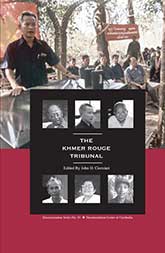 |
THE KHMER ROUGE TRIBUNAL
John
D. Ciorciari
2006
7USD
204 pages
in English
|
|
Between April 1975
and January 1979, the radical Khmer Rouge regime subjected
Cambodians to a wave of atrocities that left over one in four
Cambodians dead. For nearly three decades, call for justice went
unanswered, and the architects of Khmer Rouge terror enjoyed almost
unfettered impunity. Only recently has a tribunal been established to
put surviving Khmer Rouge officials on trial. This edited volume
examines the origins, evolution, and feature of the Khmer Rouge
Tribunal. It provides a concise overview of legal and political
issues surrounding the tribunal and answers key questions about the
accountability process. It explains why the tribunal took so many
years to create and why it became a "hybrid" court with Cambodians
and international participation. It also assesses the laws and
procedures governing the proceedings and the likely evidence
available against Khmer Rouge defendants. Finally, it discusses how
the tribunal can most effectively advance the aims of justice and
reconciliation in Cambodia and help to dispel the shadows of the
past.
Funding provided by
the United States Agency for International Development (USAID).
|
|
|
|
|
|
|
|
Monograph 11 |
|
|
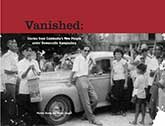
|
VANISHED:
Stories from Cambodia’s New People under
Democratic Kampuchea
Pivoine
Beang and Wynne Cougill
2006
15USD
143 pages
in English; 200 pages in Khmer
|
|
For
centuries, Cambodia’s rural peasants had lived in modest
circumstances with few entitlements, while the country’s tiny
urban elite enjoyed more opportunities and privileges. But in
April 1975 when the Khmer Rouge took control of Cambodia, they
reversed this social order.
Hundreds of thousands of city dwellers were evacuated to the
countryside, where they were forced into hard labor. Despised by
the peasants and Khmer Rouge cadres alike, these “new people”
were viewed as parasites and imperialists, and their rights and
privileges were removed. As many as two-thirds of them were
executed or died as a result of starvation, untreated diseases,
or overwork.
In
this monograph, 52 new people who survived Democratic Kampuchea
tell their stories and those of their loved ones under the Khmer
Rouge.
Funding provided by the National Endowment for Democracy (NED)
with core support from the Swedish International
Development Cooperation Agency (Sida) and the United States
Agency for International Development (USAID). |
|
|
|
|
|
|
|
Monograph 12 |
|
|
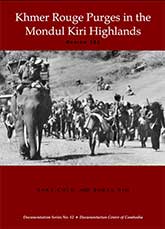 |
KHMER ROUGE PURGES IN THE MONDUL KIRI HIGHLANDS (Winds from the
West)
Sara Colm and Sorya Sim
174 pages in English
(Unpublished)
|
|
The Khmer Rouge took effective control of Mondul Kiri province in 1970, five years
before the fall of Phnom Penh and most of the rest of Cambodia. Mondul Kiri served
as an early base area for the Khmer Rouge, along with the other provinces of the
Democratic Kampuchea’s Northeast Zone (Ratanak Kiri, Stung Treng and Kratie).
The isolated forests of the northeast were home to indigenous highlanders who were
alienated from the central government in Phnom Penh, providing fertile ground for
the Khmer Rouge to build a base of popular support in the late 1960s. That
relationship soured after the Khmer Rouge imposed cooperatives and communal
eating, forced communities to relocate from their traditional lands, terminated
customary religious practices, and purged people accused of supporting Prince
Sihanouk and the Vietnamese after the U.S. bombing ended in 1973.
This monograph examines Khmer Rouge purges in Mondul Kiri, or Khmer Rouge
Region 105, from 1970 when the Khmer Rouge took effective control of the province
until 1979 when they were ousted from power. It focuses on executions of ethnic
Bunong people, who comprised the bulk of Mondul Kiri’s population during that
period, as well as ethnic Khmer cadre, soldiers, and workers living in the province. It
also looks at a number of cases where indigenous highlanders crossed the border
from Vietnam and were singled out and killed by the Khmer Rouge. These included
Bunong civilians, whose ancestral territory straddles the border, who were working
as simple farmers or laborers in the cooperatives. They were arrested on charges of
being Vietnamese spies based on circumstantial evidence: they had traveled back
and forth to Vietnam to escape the U.S. air war or to visit relatives. The Khmer Rouge
also arrested at members of the highland resistance army FULRO, after they crossed
the border from Vietnam to Mondul Kiri in 1978 to ask for help from the Khmer
Rouge in fighting their common enemy, Vietnam.
|
|
|
|
|
|
|
|
Monograph 13 |
|
|
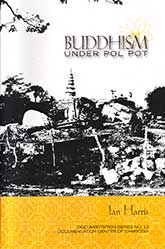 |
BUDDHISM UNDER POL POT
Ian Harris
2007
20USD
304 pages in English
|
|
This new book
by Ian Harris, Professor of Buddhist Studies at the University
of Cumbria, UK, explores the fate of Buddhism before, during,
and shortly after Democratic Kampuchea. Prum Phalla of the
Documentation Center of Cambodia provided research assistance on
this project.
Dr. Harris
begins with an examination of Buddhism under Sihanouk and Lon
Nol, and then traces the origins of Khmer Communism and its
relationship with Buddhism in Cambodia. He then looks at the
fate of Buddhism early in the regime, including monk evacuations
and flights abroad, defrocking, forced marriage, military
service, and executions. The practice of Buddhism during the
regime is also examined, including Buddhist rites and the fate
of pagodas, images, and religious texts. Dr. Harris weighs the
claims of monk deaths and pagodas destroyed during Democratic
Kampuchea against his findings from extensive interviews and
documentary research. He concludes that there was no policy for
the systematic liquidation of monks in Democratic Kampuchea.
Ian Harris and
Prum Phalla:
Ian Harris is
Professor of Buddhist Studies at the University of Cumbria, UK
and Tung Lin Kok Yuen, Visiting Professor on Buddhism and
Contemporary Society at the University of British Columbia,
Vancouver, Canada. Co-founder of the UK Association for Buddhist
Studies (UKABS) and author of many works on Buddhist ethics and
politics, his previous book was Cambodian Buddhism: History and
Practice (2005). He is currently investigating the links between
Buddhism and politics in pre-Pol Pot Cambodia.
Funding for this project was generously provided by the Swedish International Development Agency.
Support for DC-Cam’s operations is provided by the US Agency for International Development (USAID)
and Swedish International Development Agency (Sida).
|
|
|
|
|
|
|
|
Monograph 14 |
|
|
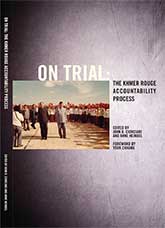
|
ON TRIAL:
The Khmer Rouge
Accountability Process
Edited by John D. Ciorciari and and Anne Heindel
Foreword by
Youk Chhang
2009
29USD
352 pages in English
|
|
|
|
n |
This book is dedicated to the victims of
Democratic Kampuchea and to
promoting a legal accountability process that will honor their
memories and provide their families with justice. |
|
|
|
|
|
|
|
|
n |
John Ciorciari
is an Assistant Professor at the Gerald R. Ford School of Public
Policy at the University of Michigan and a Senior Legal Advisor
to the Documentation Center of Cambodia. |
|
|
|
|
|
|
|
|
n |
Anne Heindel
is a Legal Advisor to the Documentation Center of Cambodia. |
|
|
|
|
|
|
|
|
n |
Youk Chhang is
Director of the Documentation Center of Cambodia. He is a
survivor of the Killing Fields and received the Truman-Reagan
Freedom Award from the Victims of Communism Memorial
Foundation in 2000. He was also named one of Time magazine’s “60
Asian Heroes” in 2006 and one of the “Time 100” most influential
people in the world in 2007 for his stand against impunity in
Cambodia and elsewhere. |
|
|
|
|
|
|
|
|
n |
“The Khmer
Rouge Tribunal is profoundly important to Cambodians and
non-Cambodians around the world. It excites passion, arouses
controversy, and offers to many victims the hope of justice too
long delayed. This timely and essential book provides an
excellent overview of the Tribunal, a thoughtful review of its
progress to date, and sensible suggestions on how it can best
meet its obligations to the Cambodian people and the
international community.”
–Dr. Sophal Ear, Assistant Professor of National Security
Affairs at the U.S. Naval Postgraduate School and survivor of
Democratic Kampuchea |
|
|
|
|
|
|
|
|
n |
This book of
essays On Trial: the Khmer Rouge Accountability Process is
well-timed, as the first ECCC trial of ‘Duch’ the former
chairman of the notorious S-21 draws to a close. On Trial will
take an important place among the many books and articles
written about the recent history of Cambodia and particularly
the Khmer Rouge period. It provides a useful historical and
intellectual context for the
trials currently underway in Phnom Penh before the ECCC. For
observers and academics its most useful sections may prove to be
those that analyse the law, jurisprudence and procedures
governing the trials and the many issues that this unique
Tribunal has overcome and has yet to resolve. The essays also
pose many insightful questions and offer some tentative
proposals for improvement in procedure and victim participation. |
|
|
|
|
|
|
|
|
|
DC-Cam has again assisted in the vital task of providing the
public with information that helps unravel the tragic puzzle of
how to deal with the aftermath of Democratic Kampuchean policies
and practices in Cambodia.
–Judge Silvia Cartwright, Extraordinary Chambers in the Courts
of Cambodia (ECCC) |
|
|
|
|
|
|
|
|
n |
This
invaluable collection of essays, sponsored by the Cambodian NGO
that has pioneered research on the Khmer Rouge era, provides a
wealth of information about the so-called Khmer Rouge Tribunal.
On Trial is accessible, well researched, and passionately
engaged with the innumerable tragedies of the Khmer Rouge
period. Its authors argue that the ongoing trials may possibly
lead toward deeper reconciliation and certainly a deeper
knowledge of what happened throughout the country in those
horrific years.
–David Chandler. Professor Emeritus of history at Monash
University, Dr. Chandler is a renowned historian of Cambodia,
whose published works include The Tragedy of Cambodian History:
Politics, War, and Revolution since 1945, Brother Number One: A
Political Biography of Pol Pot, and Voices from S-2: Terror and
History in Pol Pot’s Secret Prison. |
|
|
|
|
|
|
|
|
|
Funded and Supported by the Swedish International Development
Agency (Sida),
Sweden and the U.S. Agency for International Development (USAID),
USA. |
|
|
|
|
|
|
Monograph 15 |
|
|
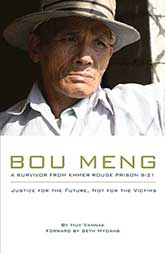 |
BOU
MENG: A
SURVIVOR FROM KHMER
ROUGE PRISON S-21
Justice for the Future, Not Just for the
Victims
|
Nearly
30 years after the fall of the brutal Khmer Rouge regime,
a survivor of its ruthless torture machine emerges from history to
announce: “I am still alive.” The
Khmer Rouge imprisoned and tortured 14,000 Cambodians at its
notorious Toul Sleng Prison, also known as “S-21.” Imprisonment
at S-21 was a certain death sentence--only a handful of men
walked out alive. Among them was Bou Meng, an artist. Years
after the collapse of the Khmer Rouge regime, one of the most
horrific in history (1975-1979), and three decades after S-21
was closed, Bou Meng was believed dead. In January 2002, an
English local newspaper in Phnom Penh reported that he had died
in 1997 or 1998, and in October 2002, a Cambodian magazine
called Searching for the Truth ran a photo of S-21
survivors gathered at the former prison site, reporting that Bou
Meng had “disappeared.”
But Bou
Meng actually survived, an astonishing escape from execution
made possible only because of his skill as a portrait artist.
During his imprisonment at S-21, Bou Meng was forced to paint
propaganda portraits of Pol Pot and other Communist
leaders. Only because of his unique talent did the murderous
leaders of S-21 keep him alive. But it could not save Bou Meng's
wife, Ma Yoeun, or his two children. Ma Yoeun was tortured and
died at the killing site, Choeung Ek. Bou Meng's children
starved to death at a Khmer Rouge child center.
Bou
Meng’s story is the story of millions of Cambodians who endured
relentless suffering, torture and imprisonment during a vicious
and murderous regime. Today, Bou Meng’s story has also become
the particular story of one man’s quest to use his memory as a
tool in the search of truth and justice.
Funding for
this project was generously provided by the U.S. Agency for
International Development (USAID) and Swedish International
Development
Agency (Sida). |
|
|
|
|
|
|
|
Monograph 16 |
|
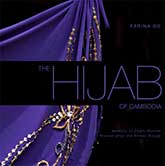 |
THE HIJAB OF CAMBODIA:
Memories of Cham Muslim Women after the Khmer Rouge
Farina
So
2011
20USD
128
page in Englsih, 174 page in Khmer
|
|
This
book examines Cham Muslim women’s experiences under the Khmer
Rouge regime through the complexities of memory and narrative
and uncovers compelling stories of survival and
resistance. Khmer Rouge genocidal policies ruptured ethnic and
religious identities and resulted in the disproportionate
death of the Cham group. Guided by their desire to preserve
their families and their cultural identity, Cham women sometimes
complied with Khmer Rouge policies, and sometimes secretly
resisted. Their recollection of this era and lost family members
contributes to the preservation of the Cham identity for future
generations, as well as the collective memories of all Cambodians.
ABOUT
THE AUTHOR
So
Farina has worked at the Documentation Center of Cambodia since
2003 and is currently team leader of its Cham Oral History
project, which records the Cham Muslim community’s memories of
the Khmer Rouge era (1975-79). This research monograph, drawn
from Ms. So’s master’s thesis, focuses on Cham Muslim women’s
experiences under the Khmer Rouge.
Ms. So
holds a BA in Accounting and Finance from National University of
Management (Cambodia) and an MA in International Affairs with a
concentration in Southeast Asian Studies from Ohio University
(USA). She has participated in international programs related to
genocide, oral history, Islam in Southeast Asia, memorialization,
information and technology, and truth commissions in Indonesia,
Bangladesh, Thailand, Germany, Malaysia, South Korea, and the
United States. Besides Khmer, her native language, she is fluent
in English and familiar with Bahasa Indo- alay and Cham.
Hijab:
Headscarves are scarves covering most or all of a woman’s hair
and head. The Arabic word hijab, which refers to modest behavior
or dress in general, is often used to describe the headscarf
worn by Muslim women. Muslim women wear the hijab for religious
reasons, including the desire to be judged for their morals,
character, and ideals instead of their appearance.
Funding
for this project was generously provided by the Open Society
Foundations (OSF) with core support from U.S. Agency for
International Development (USAID) and Swedish International
Development Agency (Sida). |
|
|
|
|
|
|
|
Monograph 17 |
|
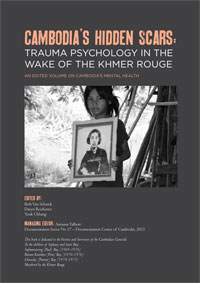 |
CAMBODIA'S HIDDEN SCARES:
Trauma Psychology in the Wake of the
Khmer Rouge
An Edited Volume on Cambodia's Mental Health
Edited by:
Beth Van Schaack, Daryn Reicherter & Youk Chhang
Managing Editor:
Autumn Talbot
2011
30USD
232
page in nglish
|
|
|
|
The Khmer Rouge Standing Committee aimed to ensure
compliance and eliminate dissent by oppressing the people through psychological
dominance. The defilement of Khmer religion, Khmer art, Khmer
familiar relations, and the Khmer social class structure
undermined deeply-held societal assumptions. The Khmer Rouge
also destabilized the mass psychology that was secure in those
realities. Cambodia's psychology was thus altered in damaging
and enduring ways. In societies that experience war and
genocide, trauma significantly impacts the people's psychology.
The ripple effects of this damage are often incalculable. There
are well-established statistics demonstrating a higher
prevalence of trauma-related mental health disorders in
post-conflict societies. this book considers the mental health
implications of the Khmer Rouge era among the Cambodia
populace. Specialists in trauma mental health discuss the
increased rates of post-traumatic stress disorder (PTSD) and
major depression, among other major mental health disorders, in
the country. They also discusses the staggering burden of such
a high prevalence of societal mental illness on a post-conflict
society. Legal experts discuss the way in which the
Extraordinary Chambers in the Courts of Cambodia can better
accommodate victims and witnesses who are traumatized to avoid
re-traumatization and to ensure a meaningful experience with
justice. The text also offers a set of recommendations for
addressing the widespread mental health issues within the
society.
Phan Srey Leab Holds a Photo of Family Members Imprisoned by
the Khmer Rouge regime
(Front
cover photo & caption by Eng Kok-Thay)
At
nine years old, Phan Srey Leab is a quiet and docile girl
with piercing eyes. She is a granddaughter of Chan Kim Srun
and Sek Sat. As a member of the military, Sek Sat rose
quickly through the ranks, first commanding the 18th
Company of Region 33 and then the 12th Regiment
in 1973. By 1977, Sek Sat was a secretary of Koh Thom
district and, by 1978, a secretary of Region 25.
On May 13,
1978, the Khmer Rouge arrested Sek Sat, his wife, and their
newborn baby boy. They arrived at Tuol Sleng Prison (S-21)
the next day. Forty days later, Sek Sat wrote a
sixty-seven-page confession, in which he admitted to
traitorous activities dating back to 1965 when he joined the
United States Central Intelligence Agency. According to the
confession, his main goals were to oppose the monarchy and
communism, and to ”hide in the revolution to build force.”
Documents
from Tuol Sleng prison do not indicate whether Chan Kim Srun
wrote a confession before she died. The only prison
document directly concerning Chan Kim Srun is a short
biography and a portrait, taken upon her arrival at S-21, of
her carrying her sleeping baby. Her brief biography,
obtained by the Documentation Center of Cambodia (DC-Cam),
indicates that she managed a handicrafts workshop in Region
25 where her husband was chief. The portrait graces the
cover of our book. In the original photo, which is on
display at Tuol Sleng Museum, it is possible to see tears
dropping from Chan Kim Srun’s eyes.
The two
had three children together. At the time of their parents’
arrest, Sek Say was eleven and her younger sister, Chreb,
was only nine. While the newborn son was imprisoned with
Sek Sat and Chan Kim Srun, both of the girls and their aunt
were jailed in a low-security prison in Koh Thom district. Chreb
& Sek Say escaped with the aid of the Vietnamese in late
1978, but Chreb died of disease before reaching safety. Sek
Say survived and moved to Kampong Speu where she remains
today in Kong Pisey district.
Sek
Say resembles her mother. She has five children, of which
Phan Srey Leab is the third. Srey Leab likes to play in the
kitchen when she can find a spot of her own. After school,
she helps her mother cook, do household chores, and look
after her younger sisters. Srey Leab only manages an
average performance at school. Srey Leab has heard her
mother blame their poverty on being orphaned at a young age.
The young girl asked once about her grandparents and what
had happened to them. Srey Leab listened to their story,
but—quiet as she is—she has never again talked about it.
Funding for this project was generously provided by the
United States Institute of Peace (USIP) with core support
from U.S. Agency for International Development (USAID) and
Swedish International Development Agency (Sida). |
|
|
|
|
|
|
|
Monograph
18 |
|
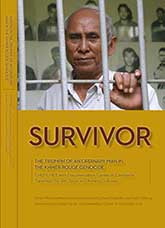 |
SURVIVOR
The triumph of an ordinary man in the Khmer Rouge
Genocide
CHUM MEY with Documentation Center of Cambodia
"Translation by Sim Sorya and Kimsroy Sokvisal"
Chum Mey's confession (with introduction by David
Chandler and
Youk Chhang)
Cover photo by Mariko Takayasu
2012
17USD
108 pages in English
|
|
Chum Mey
personifies the tormented history of his country, surviving
gunfights and rocket attacks during a civil war, losing his wife
and four children
during the brutal Khmer Rouge regime, and dragged
blindfolded into Tuol Sleng prison, where more than 12,000 people were chained and tortured and sent to a killing field. Only a handful survived, and Chum Mey's story provides a rare glimpse inside the workings of a brutal and highly organized assembly line of death.
At least 1.7 million people died between 1975 and 1979 when
the Khmer Rouge ruled Cambodia.
It was his skill as a mechanic that saved him, when after 12 days and nights of beatings and repeated electrocution, he was plucked from among the other prisoners and put to work repairing the typewriters his torturers used to record their forced confessions.
Chum Mey himself confessed to a wild fantasy of counter-revolutionary work for the CIA, an organization whose name he had never heard before his torture began. He was ready to say anything in order to stop the pain. His confession is one of the few that have been translated into English and it is reproduced in this book, the first of thousands of Tuol Sleng confessions to be published.
Over the years Chum Mey has come to understand and even identify with his torturers, rather than to condemn them. "I consider them victims like me, because they had to follow other people's orders," he says in an introduction to the book. "How can I say I would have behaved differently? Would I have had the strength to refuse to kill, if the penalty was my own death?"
He escaped death, but his survival itself continues to bewilder him. "It was such a rare chance that I survived when so many people were killed there," he says. "I think about it every night, how lucky I was to survive. Why did I survive?"
Funding for this project was generously provided by Friends of the Documentation Center
Cambodia with core support from United States Agency for International Development
(USAID). |
|
|
|
|
|
|
|
Monograph 19 |
|
 |
WHEN THE CRIMINAL LAUGHS
Terith Chy
2014
30USD
208 page in Englsih
|
|
This study of the trial of the Cambodian mass murderer Duch provides the first micro-level analysis of the personality of the defendant, victim interaction, trial structure alongside the wider history and culture of both Cambodia and war crimes trials. As such it provides a unique insight into the relationship between concepts of evil, the psychology of war criminals and the international (criminal) trial process that has lessons for both the restorative movement and the structure of war crimes and international trials. In particular, this resource book looks at the microsociological dynamics in which the individuals in the trial are both shaped by, and shape, the outcome and meaning of justice. It argues that Duch is more than just a cog in the machine in the sense that he, although following orders, personally and willingly perpetuated the consequences and enjoyed his absolute power. During his trial, Duch made efforts to co-operate, but sought acquittal at the end. For this, his efforts were seen as insincere. This research argues that his apology and remorse were genuine. It suggests that confrontation, disappointments, and conflicting defence strategies had collectively contributed to Duch's changing decision. His personality and frequent challenges by Duch and his lawyers were the cause of aggressive exchanges. Such confrontation and contestations made other parties – i.e. victims – believe he was in denial. Duch was accordingly doubly disappointed for failing himself and his victims. Besides, his co-counsels employed conflicting strategies. His international counsel presented Duch as a remorseful accused who largely admitted legal responsibility, while his national counsel presented him as a scapegoat. Through the trial, Duch was convinced that he had become a "scapegoat" and that it was unjust to prosecute him alone. Finally, this research concluded that Duch's contribution made his trial the most important achievement by the tribunal. Together with this analysis of the Duch and his trial, the book will contain a recent interview with Duch while in detention at the Khmer Rouge Tribunal and many stories of his victims.
Funding for this project was generously provided by
Norwegian Goverment and the Unites States Agency for International Development (USAID). |
|
|
|
|
|
|
|
Monograph
20 |
|
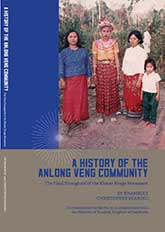 |
A HISTORY OF ANLONG VENG COMMUNITY
Khamboly Dy and Christopher Dearing
(Khmer Translation by Men Pechet)
2015
20USD
176 page in
English, 275 pages in Khmer
|
History invites moral judgments, and in studying the people of Anlong Veng, it is easy to slip into an accusatory mindset.
Anlong Veng was the final stronghold of the notorious Khmer Rouge regime—a regime which was responsible for perpetrating genocide, mass atrocity, and incalculable harm on the fabric of Cambodian society.
It is believed that over two million people died during the regime, and to this day the country still struggles with the byproducts of this history. Many of Anlong Veng's residents were former Khmer Rouge
soldiers and cadres, and without a doubt many either participated or assisted in violent acts.
The reverse can also be said, which is that in studying the people of Anlong Veng, it might be easy to slip into an empathetic mindset in which the horrors of the regime and move-ment fade in relation
to the stories and personal struggles of its individual members. Thousands of cadres and their families—including high-ranking communist leaders— were arrested and murdered throughout the country.
The regime arrested, tortured, and killed members who joined the movement from its earliest days, and there was often little recourse or escape if one was suspected of disloyalty. Without a doubt,
terror became a universal blanket that enslaved the society as a whole.
Even after the regime fell, the Cambodian population—both within and outside of Khmer Rouge-controlled territory—suffered incredibly. The over-ten-year war between Vietnam¬ese forces and the Khmer Rouge produced thousands of casualties on all sides. For several years the people were largely dependent on humanitarian assistance, and famine and dis¬ease were a constant threat.
The purpose of this book is to neither condemn nor venerate the people of Anlong Veng. Instead, we hope to provide a view into an under-studied community and a voice to an otherwise under-heard people. It is a universal rule that conflict resolution and peace is built and sustained on an open-minded discussion of the past.
Funding for this project was generously provided by
Swiss Development Agency in Cambodia with core support from Unites States Agency for International Development (USAID). |
|
|
|
|
|
|
|
Monograph
21 |
|
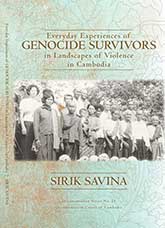 |
EVERYDAY EXPERIENCES OF GENOCIDE SUVIVORS IN LANDSCAPES OF
VIOLENCE IN CAMBODIA
Savina Sirik
2016
20USD
100
pages in English
|
This research examines the experiences of survivors who live in an unmarked site of mass violence in Cambodia, i.e., the former Khmer Rouge prison site of
Chamkar Siv in Kandal Province, during and after the Democratic Kampuchea regime (1975-79). Based on oral history interviews with survivors, this paper
constructs narratives of survivors' experiences in the landscapes of violence. The findings from this study are twofold. First, individual narratives are
important in providing a more complete understanding of the production of violence and acts of commemoration at the local level, despite the fact that memories
of past violence have been politicized and constructed to fit within the present dominant narrative. Second, although there are variations among individual experiences,
survivors' narratives are constructed in a way that corresponds to the larger historical narratives.
ABOUT THE AUTHOR
The youngest child and only girl among her four siblings, Sirik Savina was born in 1983 in
Phnom Penh, four years after the Khmer Rouge regime. She joined the Documentation Center
of Cambodia (DC-Cam) in 2004 as a volunteer and since then she progressed from working as
a field investigator to a team leader. She led the Living Documents Project at DC-Cam, where
she was responsible for planning activities, leading villagers’ tours to Phnom Penh to observe the
Extraordinary Chambers in the Courts of Cambodia’s trials, and conducting forums and film
screenings in villages. From 2013 to 2015, she headed the Museum of Memory, a project at the
Sleuk Rith Insitute, the permanent DC-Cam, in which she developed strategic planning and proposals,
coordinated with the Museum’s partners, organized exhibitions and workshops with Tuol
Sleng Genocide Museum and the National Museum of Cambodia.
In 2011, Ms. Sirik was a fellow of the Community Solutions Program, a Professional Development
Program of the Bureau of Educational and Cultural Affairs of the United States Department
of State, implemented by IREX, an international nonprofit organization providing
thought leadership and innovative programs to promote positive lasting change globally. She holds
a Bachelor of Arts in archaeology from the Royal University of Fine Arts in Phnom Penh and a
Master of Arts in Peace and Reconciliation Studies from Coventry University, UK. She recently
completed her second MA in Geography from Kent State University, USA, where she is also doing
her Ph.D. in the same major.
Funding for this project was generously provided by Unites States Agency for International Development (USAID). |
| |
|
| |
|
|
|
|
Monograph
22 |
|
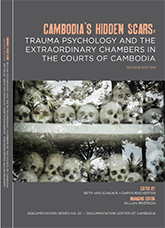 |
CAMBODIA'S HIDDEN SCARS:
Trauma Psychology and the Extraordinary Chambers in the Court of Cambodia
Edited by Beth Van Schaack, Daryn Reicherter
Managing Editors:
Gillian Reierson
2016
35USD
300 pages in English
(Second Edition)
|
The first edition of this volume was originally produced
in parallel with the Extraordinary Chambers in the Court of
Cambodia (ECCC) process with an eye toward
compiling
the current research on the enduring mental health
sequelae of the Khmer Rouge’s crimes—including
intergenerational harm—and presenting concrete recommendations to
the Royal Government of Cambodia
to address the mental health needs of the Cambodian populace. In the context of Case 002/1, however, the ECCC accepted the entire book into evidence. Furthermore, the VSS and the Civil Party lawyers were able to secure funding commitments from various states (e.g., Australia, Germany, Switzerland) to enable the ECCC to render a more meaningful reparations order than it had done in Case 001.
Given the obvious utility of the first edition of this text to the ECCC proceedings, the editors decided to update the volume with new research and scholarship. The second edition thus includes updated chapters by a number of the original authors covering the impact of international crimes on psychiatry and social psychology in general and on Cambodian survivors of the Khmer Rouge in particular. The second edition contains an entirely new chapter on transcultural psychiatry by Inger Agger. Revised chapters on the impact of trauma on the courtroom include a close analysis and a critique of the proceedings before the ECCC in Cases 001 and 002/1 and the resulting judgments. Finally, Part III includes updated recommendations, although these have not changed appreciably given the lack of progress toward building a more robust and accessible mental health system in Cambodia. All told, it is hoped that this new edition will continue to inform legal proceedings before the ECCC as well as a process of mental health reform at the national level.
Funding for this project was generously provided by Unites States Agency for International Development (USAID). |
| |
|
|
|
|
|
|
|
|
Monograph
23 |
|
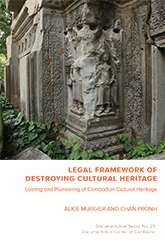 |
LEGAL FRAMEWORK OF DESTROYING CULTURE HERITAGE:
Looting and plundering of Cambodian culture heritage
Alice Murgier and Chan Pronh
2017
(Coming up)
15USD
100 pages in Khmer/English
|
Cambodia experienced political unrest, genocide and civil war for decades. Such instability led to numerous ancient Khmer temples being destroyed and/or damaged beyond repair. Cambodian antiquities were stolen and trafficked by organized teams of looters. Those antiquities continue to be transported across borders to dealers in Khmer artifacts allegedly located in Thailand and by sea to Singapore, and some of the most prominent and distinguished Western institutions have not been innocent in this trade. This paper highlights both national and international laws, which are a useful framework to deal with the looting, trafficking, and destroying of Cambodian cultural heritage during armed conflict or peacetime. The paper also interprets and analyzes those laws, one by one, and suggests ways to claim back the objects that were looted. In addition, the paper emphasizes the duty and obligation of state party of the laws, which needs to cooperate in this process.
Funding for this project was generously provided by Unites States Agency for International Development (USAID). |
| |
|
|
|
|
|
|
|
|
Monograph
24 |
|
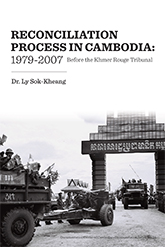 |
Reconciliation Process in Cambodia: 1979-2007
Before the Khmer Rouge Tribunal
Dr. Ly Sok-Kheang
2017
30USD
312 pages in Khmer/English
|
This dissertation attempts to fill some gaps in the reconciliation literature by presenting evidence that both state and non-state actors initiated practices to restore relationships between former adversaries after Cambodia’s 1975-1979 genocide ended. Their wide-ranging methods included exercising forgiveness, promoting peaceful co-existence, seeking justice, and acknowledging contrition and other expressions of individual culpability.
Both primary and secondary documents were analysed and nearly one hundred interviews conducted for this research, which concludes that the combination of macro (state) and micro (individual, community) reconciliation efforts permeated every facet of society. They provided Cambodians the opportunity and means to seek out peace of mind, and in doing so, possibly the capacity to forgive the wrongdoers. In the Cambodian context, forgiveness is not given in exchange for an apology. Rather, it is earned through changed behavior.
Rather than relying solely on political rapprochement or the retributive justice of the Extraordinary Chambers in the Courts of Cambodia, Cambodians took a wide variety of socio-political, cultural, legal, educational and traditional approaches and adapted them to their specific circumstances. As a result, the sporadic post-genocide vengeance meted out between former adversaries immediately after the fall of Democratic Kampuchea was replaced by the rule of law, a collective sense of humanity, a shared victimhood, the flourishing of religions and the memorialisation and teaching of Khmer Rouge history.
This dissertation contributes to a fuller understanding of the overall reconciliation process. The actions Cambodians took to heal can serve as a model for other post-conflict societies searching for reconciliatory approaches that fit their distinct cultures and religions, despite the inevitable challenges of socio-political instability.
Funding for this project was generously provided by Unites States Agency for International Development (USAID). |
|
|
|
|
|
|
|
| |
|
Monograph
25 |
|
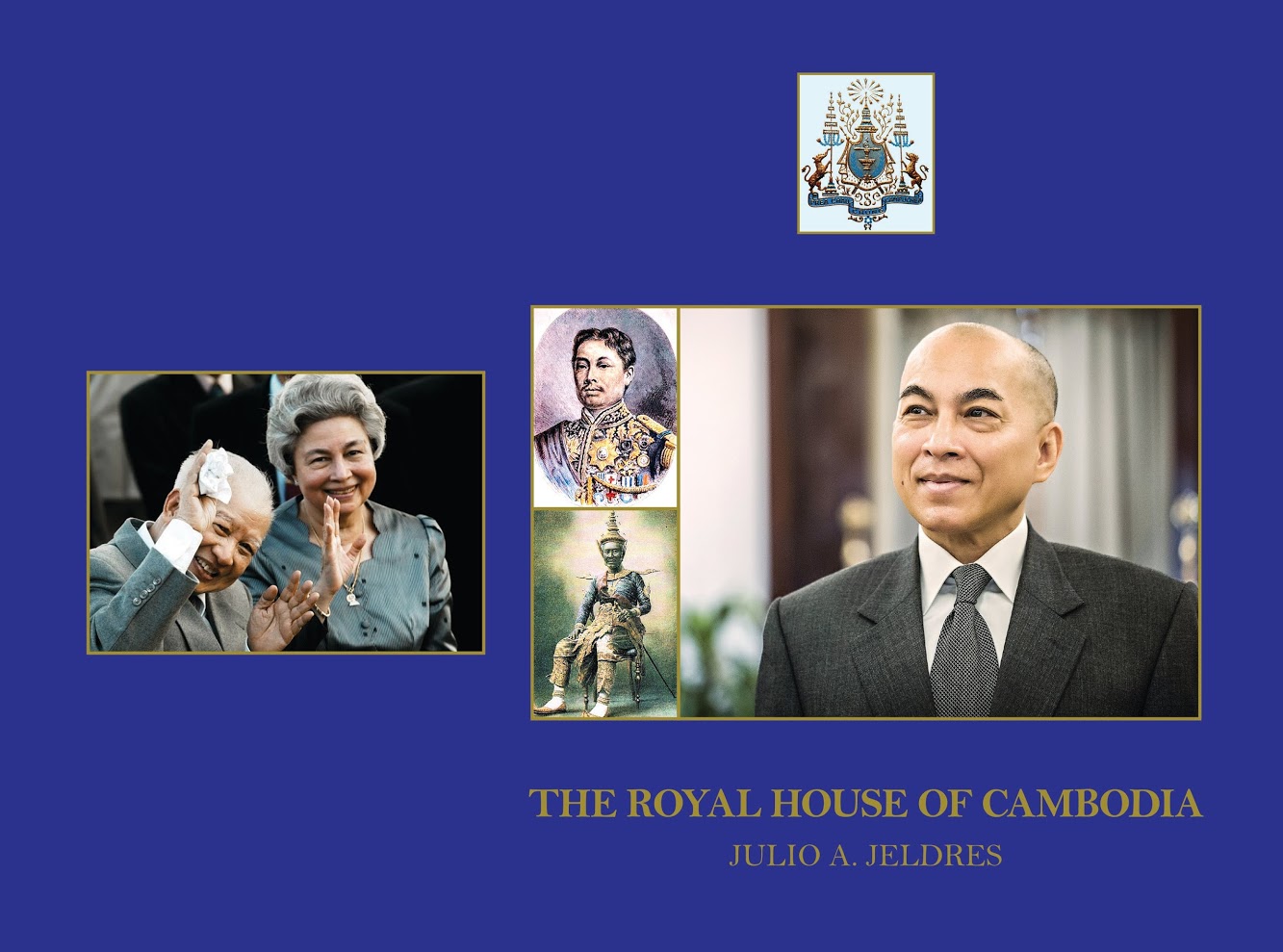 |
The Royal House of Cambodia
Ambassador Julio A. Jeldress, PhD
2017
46USD
318 pages in English
|
A new book on The Royal House of Cambodia by Ambassador Julio A. Jeldres PhD, a former Senior Private Secretary and Official Biographer to His Late Majesty the King Father Norodom Sihanouk, launched by His Majesty King Norodom Sihamoni, at the Royal Palace on 19 December 2017.
The 300+ pages book is an updated version of a smaller book written by Ambassador Jeldres in 2003 and it contains several new chapters on His Majesty King Norodom Sihamoni and other senior members of the Royal family, as well as Royal descendants working in Cambodia. It has new chapters also on previous monarchs beginning with His Majesty King Ang Duong.
New portraits of the senior members of the Royal Family have been photographed by well-known Cambodian photographer Makara Ouch.
The Book is published by the Sleuth Rith Institute/Documentation Center of Cambodia and will be distributed by Monument Books.
|
|
|
|
|
|
| |
|
|
|
l |
Translations in
Khmer |
|
|
|
|
l |
Research for Future Publication |
|
|
| |
l |
Outreach
Publication |
|
|
| |
l |
List of Publications |
|
|
|